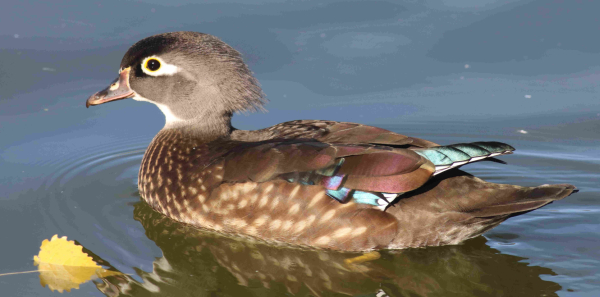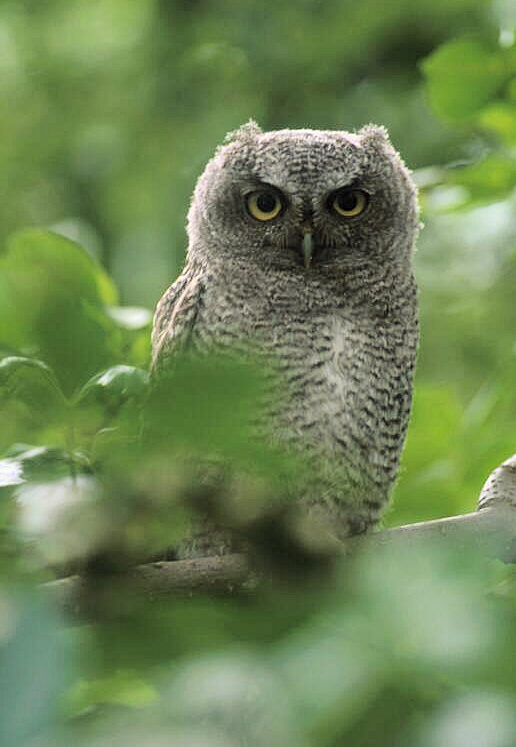
A female Wood Duck will search for an acceptable nesting cavity each spring. Will she find an suitable large cavity? You can offer an option for her by providing a big nest box.

An Eastern Screech Owl will remain near its big nest box after fledging, where it will be fed and protected by the adult pair during the extended post-fledging period.
|
Big Nest Boxes can be a big help for larger cavity nesting birds – Wood Ducks, American Kestrels, Eastern and Western Screech Owls, and others. Suitable cavities are in short supply in many areas and the addition of one or more large nest boxes can help bolster local populations of favorite birds. Wood Ducks are an example of a big conservation success with their recovery from a threatened status during the 20th Century due in part to the installation of artificial nest boxes across their nesting range. You can make a difference on a local scale for Wood Ducks and other exciting birds.
Providing a big nest box is no different than providing a birdhouse for wrens or chickadees. Wood Ducks and screech owls will nest in some neighborhoods and parks. American Kestrels prefer a more open rural area where mice and voles are common, and the owls and ducks will prosper best in a rural setting too. Wood Ducks require a nearby source of water – a marsh is best. Just as you get great satisfaction when bluebirds or Tree Swallows use your nest boxes, you will get even more excited about attracting nesting Wood Ducks, kestrels, or screech owls to a big nest box or two!
There are a few companies that sell big nest boxes, although you want to be sure they have a hinged door or panel so you can maintain (clean) and monitor your nest box. You may actually need to install a hinged panel after you buy a nest box, but that’s not hard to do quickly by using a jig saw or by removing a couple nails or screws and adding a hinge.
Nest Box Construction
If you’re a woodworker, or just an inspired birder, it’s relatively easy to build a big nest box, but keep the following list of elements in mind as you progress:
- Entrance Hole – 3 inches in diameter for Wood Ducks, American Kestrels, and Western and Eastern Screech Owls. Some birders prefer a little larger entrance hole for Wood Ducks, which they accommodate by making the hole 3 inches high and 4 inches wide.
- Overall Size – 14 inches high with side panels 10 inches and 12 inches wide is considered an optimum size for Wood Ducks, screech owls, and kestrels. (For other species, check the nest box parameters at the websites listed below.)
The best nest boxes will have a number of important features, including:
- A slanted roof to repel rain
- Thick walls for insulation
- Small ventilation holes should be drilled near the top of the nest box
- Drain holes should be drilled into the bottom corners of the nest box
- It is important to add a series of interior grooves beneath the entrance to help when nestlings are ready to fledge and climb to the entrance hole (in that case, it becomes an exit hole). Some birders prefer to tack a piece of ¼-inchwire mesh that extends from the bottom of the nest box to the entrance hole to facilitate climbing nestlings.
- And, the aforementioned, very important feature – a hinged door, usually on one side of the nest box to facilitate cleaning and monitoring.
If you buy a big nest box, make sure it has the above features. If not, add them yourself. If you wish to build your own big nest box, you can get specific construction plans for nest boxes for each species at https://nestwatch.org/learn/all-about-birdhouses/birds/wood-duck/
Beyond buying or building a big nest box, there are still a number of important considerations:
- Installing your big next box may be the toughest part of the process of providing a big nest box to birds. Many birders believe a metal pole is the best option on which to mount your nest box, although a strong wooden pole is almost as good. Part of the importance of how to install a nest box is the need to provide predator proofing.
- Predator-proofing is required for all nest boxes. Potential predators include snakes, squirrels, and raccoons. For big nest boxes, a stovepipe guard or conical guard are most effective.
- Position big nest boxes 8 to 30 feet above ground; for Wood Ducks, position the entrance hole toward water; for other species position the entrance hole facing south or east.
- Choose an appropriate habitat – open woodlands is good for all the aforementioned species, and Wood Ducks need to nest near a shallow marsh (within a hundred yards or so).
- Cover the bottom of the nest box with a couple inches of wood chips for owls and kestrels that do not build nests, and even for female Wood Ducks that will line their nest with down.
- Maintenance includes cleaning old nests and any debris from each nest box, and adding new wood chips. This timely maintenance is obviously important, and that’s when the hinged panel of the nest box is key (as referred to above). Double check the latch to make sure it holds the door closed securely.
When installing any nest box, keep in mind that not all nesting attempts are successful, so don’t take any unsuccessful nesting attempts personally, as long as you have provided protection from predators and addressed other potential nest box problems such as drainage and maintenance.
Make a big nest box project a fun aspiration and a rewarding goal. It’s not a small undertaking, but it can make a big difference to some cavity nesting birds around you.
For more information, see the Cornell Lab’s NestWatch webpages at https://nestwatch.org/learn/all-about-birdhouses/birds/wood-duck/ & https://nestwatch.org/learn/all-about-birdhouses/birds/eastern-screech-owl/ &https://nestwatch.org/learn/all-about-birdhouses/birds/american-kestrel/ & https://nestwatch.org/learn/all-about-birdhouses/features-of-a-good-birdhouse/
Also, refer to information provided by The Wood Duck Society http://www.woodducksociety.com/bestpractices.htm and the National Wildlife Federation at https://www.nwf.org/~/media/PDFs/Wildlife/duck_box_plans.ashx
Share your backyard birding experiences and photos at editorstbw2@gmail.com